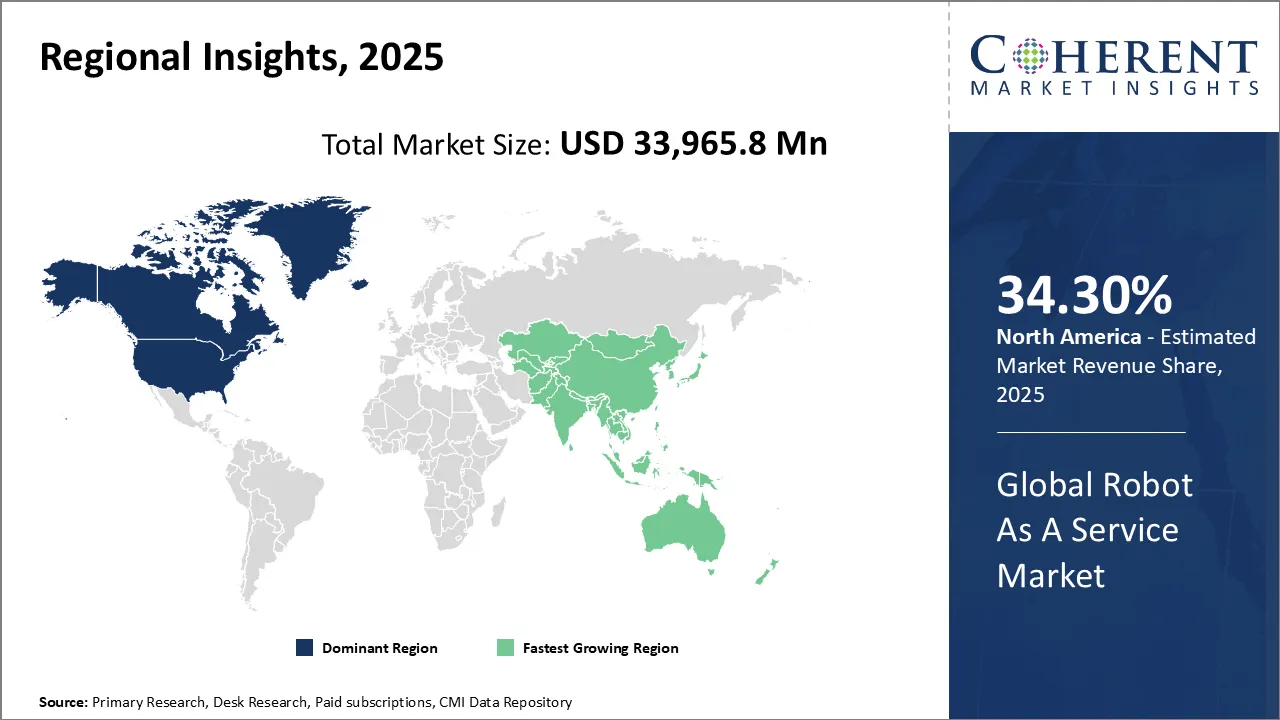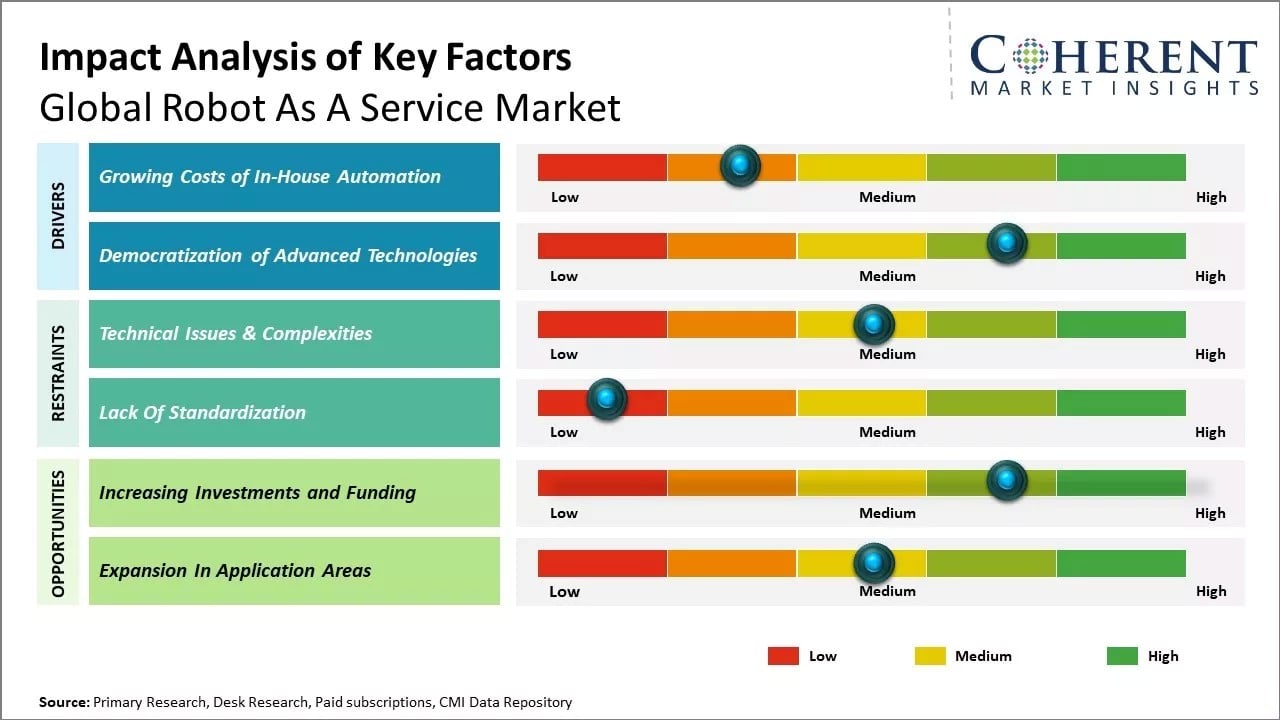
The global robot as a service market is estimated to be valued at USD 33,965.8 Mn in 2025. It is poised to exhibit a compound annual growth rate (CAGR) of 21.4% from 2025 to 2032, surpassing USD 1,31,723.5 Mn by 2032.
The global robot as a service market is expected to experience strong growth during the forecast period. This is mostly due to increasing automation across industries, advancements in robotics technology, and growing demand for cost-effective operational solutions.
RaaS offers flexible deployment models that reduce upfront capital investments. This is making it particularly attractive for small and medium enterprises looking to improve efficiency as well as scalability.
A notable example is the recent launch Primech AI’s latest launch. In March 2025, Primech AI Pte. Ltd. started a new Robotics-as-a-Service business. The company also signed an MOU with CCG Property Services to use its AI-powered HYTRON robot for fully automated toilet cleaning in selected facilities.
Despite promising growth, the market must navigate challenges including integration complexity, data security concerns, and workforce adaptation. Nonetheless, the ongoing evolution of AI, machine learning, and edge computing is expected to accelerate the expansion of RaaS across a broader range of industries during the forthcoming period.
Artificial intelligence (AI) is revolutionizing the robot as a service market by enabling smarter, autonomous decision-making, improving robot adaptability, and enhancing operational efficiency across industries. AI-driven RaaS solutions are significantly boosting performance in logistics, healthcare, security, and customer service by facilitating real-time analytics, intelligent navigation, and human-robot interaction.
Advancements in AI and automation are improving efficiency in robot as a service solutions across various industries. Many companies are using advanced technologies like AI in their products to woo more and more customers. For instance,
|
Current Event |
Description and its Impact |
|
AI-Powered Robotaxi Expansion and Robot-as-a-service market Growth |
|
|
Surge in Healthcare Robot Deployments Post-Pandemic |
|
Uncover macros and micros vetted on 75+ parameters: Get instant access to report
The professional service robot segment is expected to lead the global robot as a service market with a dominant 72.9% share in 2025. This is mostly due to rising adoption of automation across manufacturing and logistics sectors.
Professional service robots are increasingly deployed to perform critical industrial tasks such as material handling, assembly, inspection, and machine tending. Their integration helps businesses boost productivity, improve operational efficiency, and enhance workplace safety.
Mobile robots and collaborative robots (cobots) are witnessing strong demand across various industries. This is due to their ability to streamline workflows and work alongside human operators.
A good example of this is the recent partnership between GXO and Agility Robotics. In June 2024, the logistics company GXO signed a multi-year agreement with Agility Robotics to use the humanoid robot Digit in its logistics operations. This agreement claimed to be both the industry’s first formal commercial deployment of humanoid robots and first Robots-as-a-Service (RaaS) deployment of humanoid robots.
Mobile robots enable autonomous material transport across production lines, reducing reliance on manual labor for repetitive tasks as well as improving layout flexibility. Meanwhile, cobots are gaining traction thanks to their ease of use, safety features, and ability to augment human workers in complex or ergonomically risky operations.
As factories move toward just-in-time manufacturing and mass customization, logistics and material-handling robots are playing a key role in ensuring timely inventory movement and reducing production disruptions. The versatility and operational benefits offered by professional service robots are expected to reinforce their dominant position in the robot-as-a-service market.
As per Coherent Market Insights’ latest robot as a service market report, logistics segment is set to dominate market during the forecast period. This can be attributed to rapid expansion of e-commerce and the growing need for efficient, automated fulfillment solutions.
Robotics technologies are increasingly deployed in logistics operations to streamline warehouse processes such as picking, sorting, transporting, and packaging. Autonomous mobile robots (AMRs) and robotic arms are widely used to accelerate throughput, reduce errors, and operate continuously without the limitations of manual labor. These robots enhance productivity as well as enable scalable operations in high-volume distribution centers.
Rise of fast delivery expectations has also increased the adoption of robotics in last-mile logistics, with pilot programs testing autonomous delivery robots to improve delivery efficiency. As e-commerce volumes continue to surge and supply chains become more complex, demand for robotics-enabled logistics solutions is expected to remain strong during the forthcoming period.

To learn more about this report, Download Free Sample
North America is expected to dominate the global robot-as-a-service market with a 34.3% share in 2025. This is attributable to a strong ecosystem of robotics innovation, advanced industrial automation, and a mature technology infrastructure.
The region benefits from the presence of leading robotics companies and startups that are driving the development and commercialization of RaaS solutions. For instance, Brightpick unveiled Autopicker 2.0, an advanced version of its flagship multi-purpose AI robot, in June 2025.
Rising labor costs and growing need for flexible automation are prompting businesses in logistics, healthcare, and manufacturing to favor subscription-based robotics models. This shift allows companies to access advanced robotic solutions without the burden of large upfront capital investments.
Additionally, North America’s early adoption of emerging technologies, including collaborative robots and AI-enabled automation, continues to accelerate RaaS deployment across various industries. These factors position North America as a central hub for RaaS innovation and implementation in the global market.
Asia Pacific is poised to be emerge as a highly lucrative pocket for robot as a service market companies during the forecast period. This is attributable to rapid industrialization, rising labor costs, and increasing demand for automation across key economies such as China, Japan, South Korea, and India.
China continues to lead in industrial robotics production, with significant public and private investments in AI and automation technologies. Meanwhile, countries like India and Southeast Asian nations are experiencing rising demand for robotic solutions as businesses seek to enhance productivity and offset workforce shortages.
Robot providers are localizing offerings and adopting flexible pricing models, including pay-per-use, to improve accessibility and adoption across cost-sensitive markets. With favorable government initiatives and a strong push for digital transformation, Asia Pacific is expected to be a major growth engine for the Robot-as-a-service market in the years ahead.
The United States is anticipated to account for a prominent global market share of 29.5% in 2025. This can be attributed to the country's robust technology ecosystem, advanced industrial infrastructure, and strong focus on automation.
Presence of leading robotics firms and tech innovators, along with a mature base of early adopters across manufacturing, healthcare, logistics, and retail sectors, supports continued growth in subscription-based robotic solutions. Market expansion is also fueled by rising labor costs, workforce shortages, and the increasing need for operational flexibility.
Businesses are turning to RaaS to reduce upfront capital investment, increase scalability, and access cutting-edge robotics integrated with AI and machine learning. The model allows companies to optimize productivity while outsourcing maintenance, upgrades, and technical support to service providers.
With a well-developed network of R&D institutions, supportive policy frameworks, and high digital readiness, the U.S. continues to lead in the commercialization and deployment of service and collaborative robots. Growing demand for warehouse automation, autonomous delivery solutions, and surgical robotics is expected to further solidify the U.S. as a global hub for RaaS innovation and adoption.
China is slated to hold 11.1% of the global robot as a service industry share in 2025. This is mainly due to the country’s strong focus on industrial automation and smart manufacturing.
The Chinese government has been actively promoting robotics adoption through initiatives like “Made in China 2025”. These initiatives encourage factories to use robots to improve efficiency and reduce labor costs. Many local manufacturers are also turning to RaaS models because they allow companies to use advanced robots without making large upfront investments.
Another major growth driver is the expanding use of service robots in sectors like healthcare, logistics, and retail. For example, delivery robots and cleaning robots are becoming more common in Chinese cities, while hospitals are increasingly adopting robotic assistance for patient care and disinfection.
| Report Coverage | Details | ||
|---|---|---|---|
| Base Year: | 2024 | Market Size in 2025: | USD 33,965.8 Mn |
| Historical Data for: | 2020 To 2024 | Forecast Period: | 2025 To 2032 |
| Forecast Period 2025 to 2032 CAGR: | 21.4% | 2032 Value Projection: | USD 1,31,723.5 Mn |
| Geographies covered: |
|
||
| Segments covered: |
|
||
| Companies covered: |
ABB, Aethon, Bastian Solutions, LLC, Boston Dynamics, CYBERDYNE INC., Daifuku Co., Ltd., DeLaval, Dematic, DJI, ecoRobotix Ltd, Hitachi, Ltd., Intuitive Surgical, KONGSBERG, KUKA AG, Lely, Neato Robotics, Inc., Northrop Grumman, OMRON Corporation, Parrot Drone SAS, SoftBank Robotics, Starship Technologies |
||
| Growth Drivers: |
|
||
| Restraints & Challenges: |
|
||
Uncover macros and micros vetted on 75+ parameters: Get instant access to report

To learn more about this report, Download Free Sample
Large manufacturing firms and businesses have traditionally faced high capital expenses to automate in-house processes. Upfront investments in robotic equipment, tools, and programming require extensive planning, often months or years ahead. Additionally, ongoing costs for maintenance teams and technical support add to the fixed operational burden, limiting companies’ ability to swiftly adapt to shifting market demands.
Robot-as-a-Service providers are addressing these challenges by offering scalable, flexible automation through an operational expenditure model. Instead of owning costly robotic assets, businesses can outsource automation needs and pay only for actual usage hours. Service providers remotely manage maintenance and upgrades, freeing businesses from staffing and upkeep complexities.
For example, in April 2020, Japan-based company UBTECH Robotics introduced medical robots for body temperature monitoring and disinfection in hospitals. Such innovations, combined with rising automation demand across sectors including logistics, manufacturing, healthcare, and retail, have significantly boosted the adoption of RaaS solutions globally.
The aviation industry is working on new technologies to build the first zero-emission commercial aircraft. One major step in this direction is the use of green hydrogen, which helps reduce carbon emissions.
Many governments and companies are investing in green hydrogen projects, such as hydrogen production plants and refueling stations. These growing investments are expected to boost the global robot-as-a-service market growth in the coming years.
Rising investments and funding from both private and public sectors are significantly accelerating innovation in robotics. They are also expanding the viability of robot-as-a-service models.
Capital inflows are enabling companies to develop more affordable, flexible, and intelligent robotic solutions, while allowing businesses to access these technologies without incurring high upfront costs. This shift is making robotics more accessible to small and medium enterprises, supporting broader adoption across diverse industries.
In December 2024, Robonnement raised US$ 15 million in asset-based financing to expand its RaaS platform across Europe. The funding is being used to scale its robotic fleet and onboard new integrators, allowing SMEs in countries such as Switzerland, Germany, and Austria to rent robotic solutions through subscription models rather than making capital purchases. This demonstrates the growing investor confidence in the scalability and future potential of the robot as a service market.
Share
Share
About Author
Ramprasad Bhute is a Senior Research Consultant with over 6 years of experience in market research and business consulting. He manages consulting and market research projects centered on go-to-market strategy, opportunity analysis, competitive landscape, and market size estimation and forecasting. He also advises clients on identifying and targeting absolute opportunities to penetrate untapped markets.
Missing comfort of reading report in your local language? Find your preferred language :
Transform your Strategy with Exclusive Trending Reports :
Frequently Asked Questions
Joining thousands of companies around the world committed to making the Excellent Business Solutions.
View All Our Clients